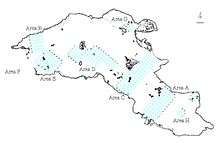Manot Cave
The Manot Cave (Hebrew: מערת מנות Me'ara Manot) is a cave in Western Galilee, Israel, discovered in 2008.[1] It is notable for the discovery of a skull that belongs to a modern human, which is estimated to be 54,700 years old. The partial skull was discovered at the beginning of the cave's exploration in 2008. Its significance was realised after detailed scientific analysis, and was first published in an online edition of Nature on 28 January 2015.[2][3] This age implies that the specimen is the oldest known human outside Africa, and is evidence that modern humans lived side-by-side with Neanderthals.[4] The cave is also noted for its "impressive archaeological record of flint and bone artefacts".[4] Geologically, it is an "active stalactite cave".[5]
Discovery
The Manot Cave is situated in Western Galilee, about 10 km north of the HaYonim Cave and 50 km northeast of Mt. Carmel Cave. It was discovered accidentally during a construction work in 2008 when a bulldozer struck open its roof.[6] Experts from the Cave Research Unit of Hebrew University of Jerusalem immediately made the initial survey. Important finds were stone tools, charcoal pieces, and human remains. The tools consisted of a Levallois point, burins, bladelets, overpassed blades, and Aurignacian tools such as nosed and carinated endscrapers. There were also remains of "fallow deer, red deer, mountain gazelle, horse, aurochs, hyena, and bear".[1] The major find was an almost complete human skull. The finds were reported to the Israel Antiquities Authority (IAA), which granted another survey. Ofer Marder and H. Khalaily made the survey and found that it was a rich archaeological site. Recognising its importance, the IAA granted a full-scale excavation in 2010. For three weeks the site was excavated by a collaboration of archaeologists from Hebrew University of Jerusalem, Tel Aviv University, Geological Survey of Israel, Zinman Institute of Archaeology of University of Haifa, Kimmel Center for Archaeological Sciences of Weizmann Institute of Science, and the Department of Archaeology of Boston University.[1]
Description

The Manot Cave consists of a lengthy hall, 80 m long and between 10m and 25m wide. Two lower chambers are connected to it from north and south. It is possible that the main entrances were at both the eastern and western ends. The cave has active stalagmite formations. Archaeological remains indicate that the most recent artifacts belong to the Early Palaeolithic period. This further indicates that the cave had been completely sealed for at least 15,000 years. The blockage was probably due to rock falls and active stalagmites at the main entrances.[1]
Significance in human evolution
The most important find in the cave is a partial skullcap of a modern human, referred to by archaeologists as Manot 1. The specimen is estimated (using uranium–thorium dating) to be 54,700 years old.[2] If correct, the find is significant. Not only is it from the oldest known modern human found outside Africa, but it is the first physical evidence that supports the Out of Africa theory, which states that modern humans left Africa around 70,000 years ago.[7] This estimate had previously been supported only by genetic evidence.[8][9] In addition, it shows that modern humans lived together with another human species, the Neanderthals, in the Levant. This could support the notion that these two species had interbred, as evidenced by genome sequencing.[10][11]
References
- 1 2 3 4 Barzilai, O; Hershkovitz, I; Marder, O; Ayalon, A; Bar-Mathews, M; Bar-Oz, G; Boaretto, E; Berna, F; et al. (31 December 2012). "Manot Cave". Hadashot Arkheologiyot. The Israel Antiquities Authority. Retrieved 2 February 2015.
- 1 2 Hershkovitz, Israel; Marder, Ofer; Ayalon, Avner; Bar-Matthews, Miryam; Yasur, Gal; Boaretto, Elisabetta; Caracuta, Valentina; Alex, Bridget; et al. (2015). "Levantine cranium from Manot Cave (Israel) foreshadows the first European modern humans". Nature. Epub ahead of print. doi:10.1038/nature14134. PMID 25629628.
- ↑ "55,000-Year-Old Skull Fossil Sheds New Light on Human Migration out of Africa". Science News. Retrieved 2 February 2015.
- 1 2 Connor, Steve (28 January 2015). "Human skull discovery in Israel proves humans lived side-by-side with Neanderthals". The Independent. Retrieved 3 February 2015.
- ↑ "Manot Cave, Israel". Find a Dig. Retrieved 3 February 2015.
- ↑ "Archaeologists Reopen Investigation of Early Humans at Manot Cave in Israel". Popular Archaeology. 28 March 2013. Retrieved 2 February 2015.
- ↑ American Friends of Tel Aviv University (29 January 2015). "Ancient skull shows modern humans colonized Eurasia 60-70,000 years ago". ScienceDaily. Retrieved 2 February 2015.
- ↑ Comas, Iñaki; Coscolla, Mireia; Luo, Tao; Borrell, Sonia; Holt, Kathryn E; Kato-Maeda, Midori; Parkhill, Julian; Malla, Bijaya; et al. (2013). "Out-of-Africa migration and Neolithic coexpansion of Mycobacterium tuberculosis with modern humans". Nature Genetics. 45 (10): 1176–1182. doi:10.1038/ng.2744. PMC 3800747
 . PMID 23995134.
. PMID 23995134. - ↑ Behar, Doron M.; Villems, Richard; Soodyall, Himla; Blue-Smith, Jason; Pereira, Luisa; Metspalu, Ene; Scozzari, Rosaria; Makkan, Heeran; et al. (2008). "The dawn of human matrilineal diversity". The American Journal of Human Genetics. 82 (5): 1130–1140. doi:10.1016/j.ajhg.2008.04.002. PMC 2427203
 . PMID 18439549.
. PMID 18439549. - ↑ Sankararaman, Sriram; Patterson, Nick; Li, Heng; Pääbo, Svante; Reich, David; Akey, Joshua M. (2012). "The date of interbreeding between Neandertals and modern humans". PLoS Genetics. 8 (10): e1002947. doi:10.1371/journal.pgen.1002947. PMC 3464203
 . PMID 23055938.
. PMID 23055938. - ↑ Wang, S.; Lachance, J.; Tishkoff, S. A.; Hey, J.; Xing, J. (2013). "Apparent variation in Neanderthal admixture among African populations is consistent with gene flow from Non-African populations". Genome Biology and Evolution. 5 (11): 2075–2081. doi:10.1093/gbe/evt160. PMC 3845641
 . PMID 24162011.
. PMID 24162011.
Coordinates: 33°02′06″N 35°11′36″E / 33.035125°N 35.193293°E